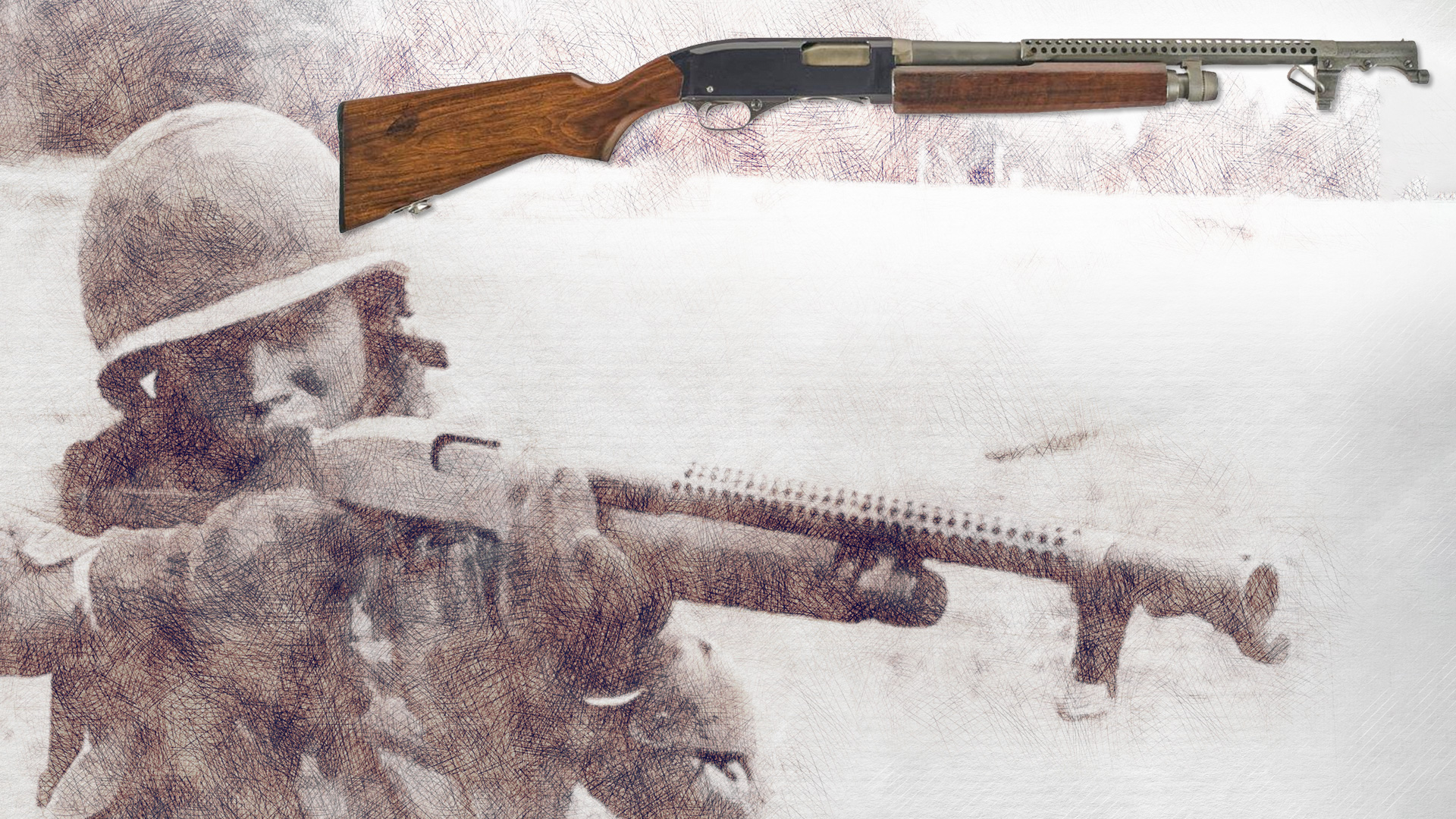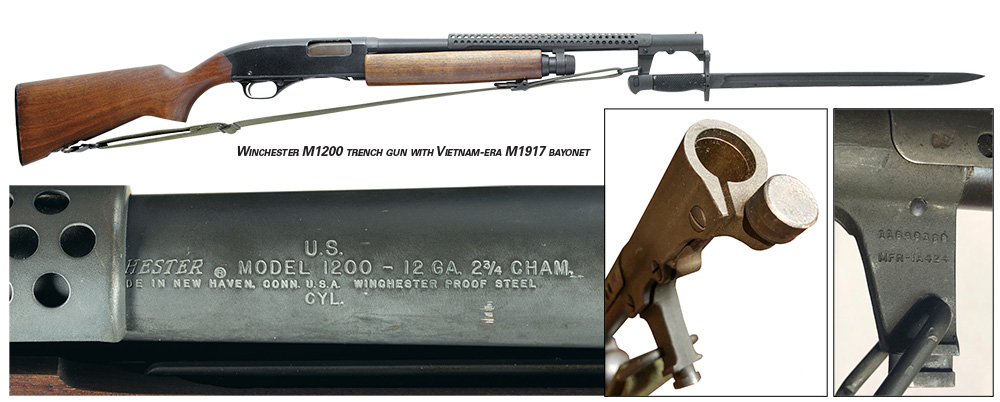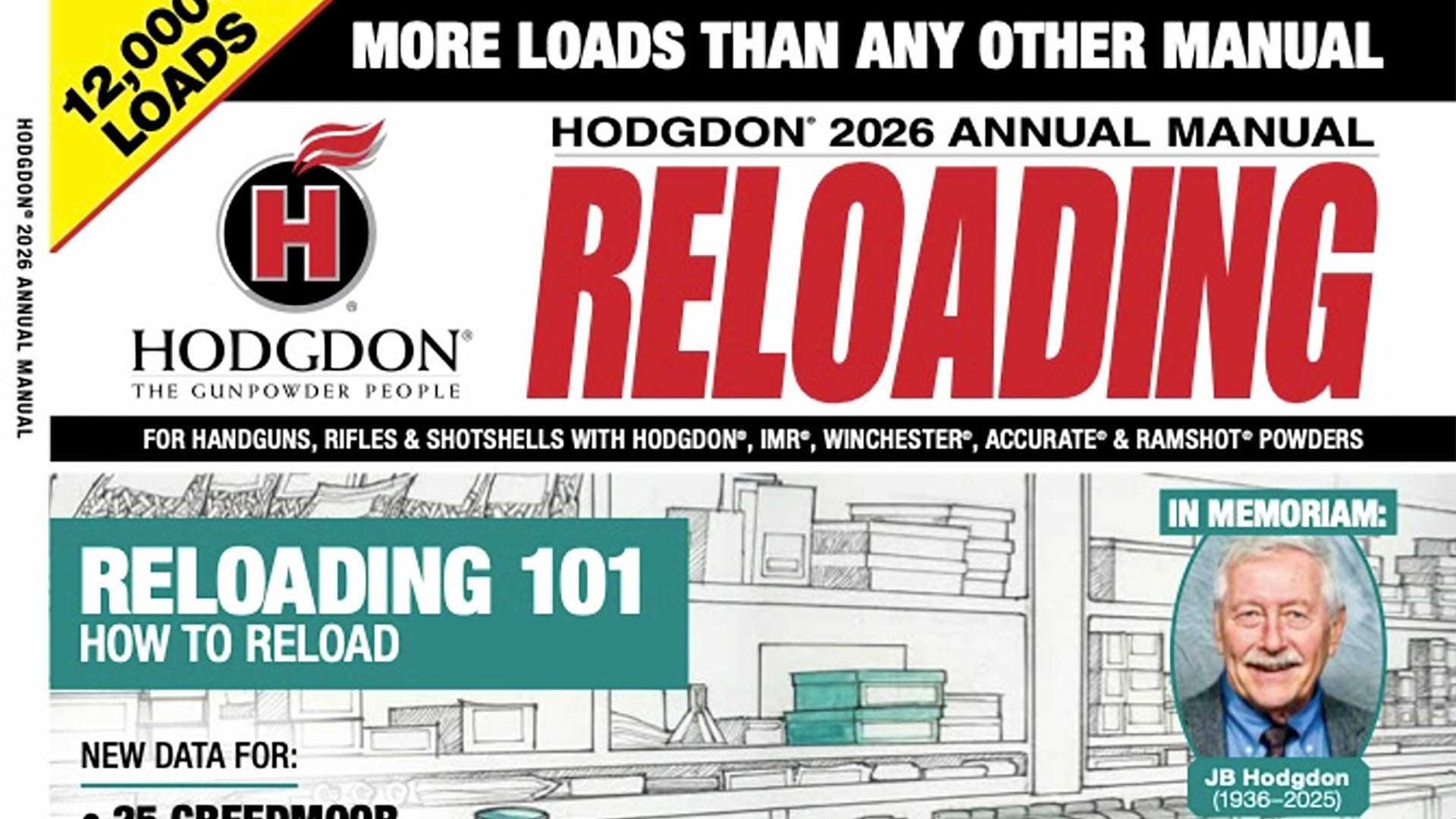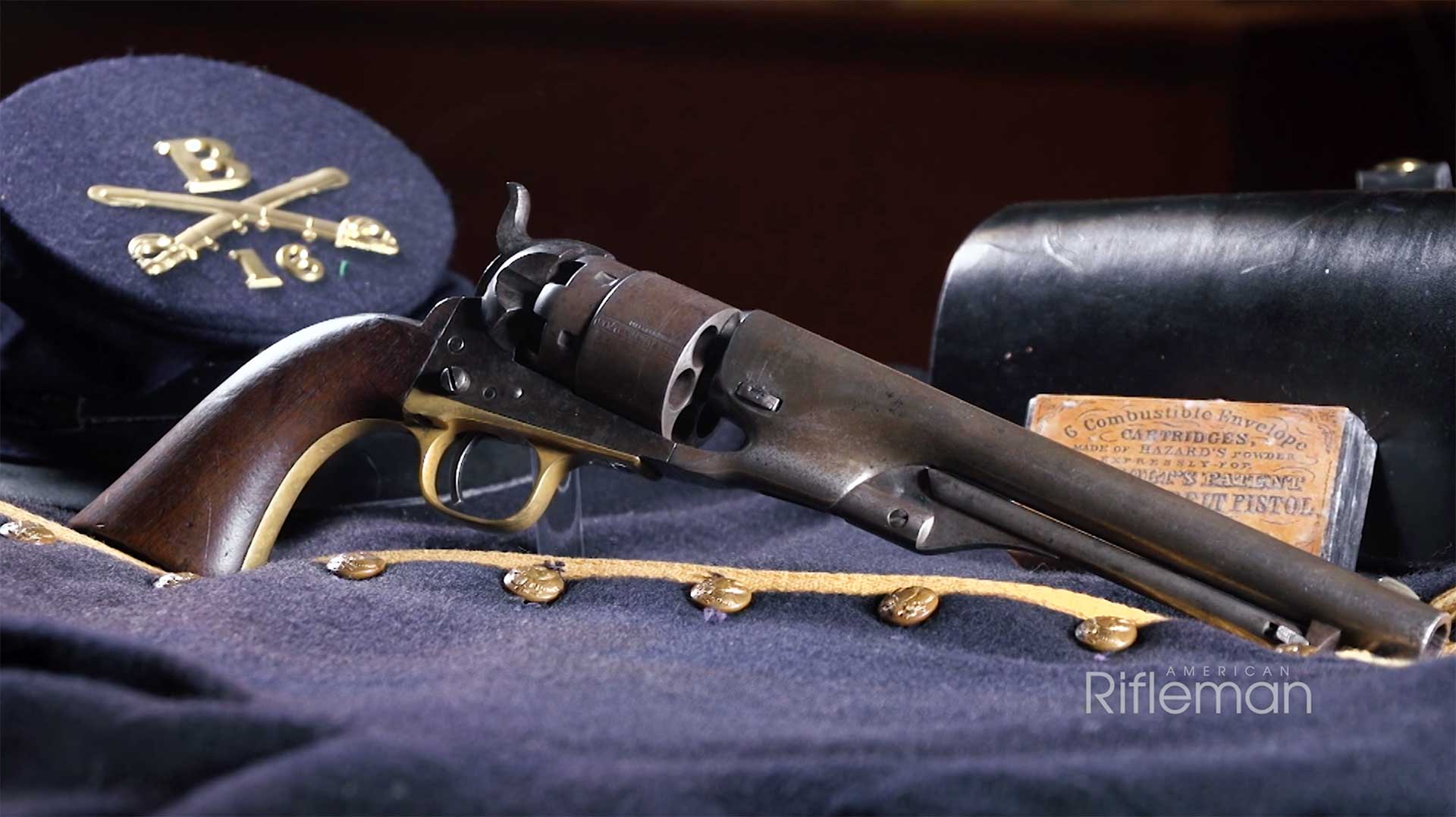
Even before the founding of our republic, American fighting men were using shotguns with notable effectiveness. Although not officially standardized, shotguns saw use in the Mexican-American War, the Civil War, various campaigns in the American West and in the Philippines following the Spanish-American War. However, it was not until America’s active involvement in World War I that a shotgun specifically designed and intended for combat was developed.
In order to provide firearms to help our soldiers in the unfamiliar environment of trench warfare, a version of the Winchester Model 1897 pump-action 12-ga. shotgun fitted with a bayonet adapter and protective ventilated metal handguard was adopted and put into production. The handguard/bayonet adapter assembly was designated as the “Type W” and designed for use with the Model 1917 bayonet as issued with the “U.S. Enfield” Model 1917 rifle. The Model 1917 bayonet was selected primarily due to the fact it was available in greater numbers than the Model 1903 Springfield rifle’s Model 1905 bayonet. Remington also developed a version of its Model 10 shotgun that used a wooden handguard and a separate bayonet lug, also fitted for the Model 1917 bayonet.
These shotguns were soon nicknamed “trench guns” in recognition of their intended purpose, but this was never an official designation. The guns were routinely, but not always, referred to in government documentation as “riot guns,” with reference made to being equipped with a “bayonet attachment.” Collectors today use the term “trench gun” to distinguish these from the plain, short-barrel “riot” shotguns not equipped with bayonets. For the sake of clarification, the term “trench gun” in this article (with the exception of the Model 10) refers to the short-barrel slide-action guns fitted with Type W handguard/bayonet adapter assemblies (or similar versions) adapted for the Model 1917 bayonet and equipped with sling swivels.
By the time of the Armistice, growing numbers of Model 1897 and Model 10 trench guns were in the hands of the doughboys fighting in the battlefields of France. After conclusion of the war, the trench guns remained in the government’s inventory and saw limited use between the wars.
When the United States became an active participant in the Second World War following Pearl Harbor, shotguns were among the firearms needed to equip our rapidly expanding armed forces. The World War I-era Model 1897 trench guns still in inventory were refurbished as necessary, but it was apparent that many more trench guns would be needed for combat—as well as riot guns for security/guard duty and long-barrel shotguns for training and recreational purposes. In early 1942, procurement contracts were given to several armsmakers for trench guns. These guns were the Winchester Model 1897 and Model 12, the Ithaca Model 37 and the Stevens Models 520-30 and 620A. The Winchester trench guns were the most widely issued during the war, but all proved to be serviceable and reliable firearms.
Contract specifications called for all such guns to be 12-ga., pump-action shotguns fitted with the Type W-style handguard/bayonet adapter assemblies to accommodate the M1917 bayonet. Although no M1917 bayonets had been manufactured for almost a quarter-century, there were still sufficient numbers on hand to equip the new trench guns. It would have been a simple matter to slightly modify the new handguard/bayonet adapter assemblies for use with the M1905 and M1 bayonets that were standardized for the M1 Garand and M1903 rifles, the primary U.S. service rifles of World War II. However, there were still fair numbers of World War I Model 1897 trench guns in use, and introduction of the newer bayonets would have meant that two different types of bayonets would have to be required for the trench guns; it made logistics easier to stay with the M1917 bayonet.
After the conclusion of the Second World War, the Winchester Model 12 and the two Stevens trench guns were retained as the military’s standard combat shotguns. There were enough of these guns on hand to meet the demand for the foreseeable future, and no new combat shotguns were procured from 1945 to the expansion of America’s involvement in Vietnam in the early 1960s. As troop deployment to Southeast Asia steadily increased, the World War II trench guns still in inventory were refurbished as necessary and issued. The supply rapidly became depleted, and it was necessary to procure new shotguns for both American troops and those of our South Vietnamese allies. In November 1962, Ithaca received production contracts for substantial numbers of Model 37 shotguns. Virtually all of these were of riot-gun configuration, although very limited numbers of Model 37 trench guns were also procured. These were very similar to the World War II Model 37 trench guns but were Parkerized rather than blued. Like the World War II variant, the Vietnam-era Model 37 trench gun utilized the M1917 bayonet. In addition to the Model 37 shotguns, sizeable numbers of Savage Model 77E riot guns and Remington Model 870 riot guns were acquired, but these were not designed to be equipped with bayonets.

Sergeant First Class Morris Brook from the Arizona Army National Guard, 215th Regional Training Institute, fires an M1200 trench gun during the 2015 Biathlon Shooting Competition at Florence Military Reservation, Ariz. Arizona National Guard photo.
One of the most widely used trench guns during World War II was the Winchester Model 12, but the company ceased production of the Model 12 in 1964, as it was an expensive gun to manufacture. When the Model 12 was dropped from Winchester’s product line, the slide-action Model 1200 was introduced as a replacement in 1964. The new shotgun utilized the latest in firearm manufacturing technology, including an aluminum-alloy receiver that was cheaper to produce and lighter than the Model 12’s finely machined, milled-steel receiver. The use of an aluminum receiver was made possible by the utilization of a high-strength steel barrel extension into which the rotating bolt’s locking lugs could be firmly secured. The receiver also had the advantage of being rust- and corrosion-resistant, but the alloy composition required the use of an anodized finish since it could not be blued or Parkerized in the conventional manner.
When the Model 1200 was introduced, the general reaction of the gun-buying public was rather lukewarm. It was looked upon with disfavor by some potential customers when compared to the superbly crafted and finely finished Model 12. The gun eventually gained some measure of success in the commercial market, and several variants were made, including a riot-gun version primarily for civilian law enforcement and security use.
When the demand for new combat shotguns increased in the 1960s, Winchester developed a “trench-gun” version of the Model 1200 for consideration by the U.S. Army. The firearm was adopted, and deliveries began in mid-1968 and continued into 1969. This was the final type of U.S. military shotgun that utilized the M1917 bayonet, and thus has the distinction of being America’s last “trench gun.”
The serial number and a “U.S.” marking were stamped on the bottom of the receiver in front of the loading port. The left side of the barrel was marked “U.S.” along with the standard Winchester factory markings. Some of the Model 1200 military shotguns were fitted with checkered fore-ends and stocks, but most were delivered with plain, unadorned wood. The buttplate was checkered plastic. The guns were fitted with sling swivels capable of being used with the standard service rifle slings. A limited number of M1200 trench guns were subsequently fitted with folding stocks, but most retained the standard wooden stocks.
The most interesting feature of the military-contract Model 1200 was the fact that, like the previous trench guns, it was designed to be used with the M1917 bayonet. The ventilated metal handguard/bayonet adapter assembly was similar to the Type W design used with the World War I- and World War II-era trench guns. It attached to the barrel in the same manner, via three transverse screws that mated with three shallow grooves on the bottom of the barrel.
There were, however, several notable differences: The M1200 assembly had a flange near the end of the barrel sleeve that prevented the 20" barrel from protruding completely through the sleeve. Thus, a small portion of the adapter sleeve served as an extension of the barrel. In addition, rather than being forged as were the World War I- and World War II-era assemblies, the M1200 bayonet lug assembly was of cast construction. The left side was marked with the manufacturer’s code and the assembly’s stock number. Also, the entire adapter/handguard assembly was Parkerized rather than blued, as the earlier variants were.
When the M1200 “trench gun” went into production, the available supply of the First World War-vintage Model 1917 bayonets had become exhausted, and it was necessary to procure additional bayonets. There has been some speculation as to why the Winchester Model 1200 military shotgun was adapted for use with a bayonet that hadn’t been in production for a half-century rather than one of the current issue bayonets such as the M7 used with the M16 rifle. Once again, the most logical explanation is that there were a number of the World War II-vintage trench guns still in use, and changing to another bayonet would have resulted in two different types of bayonets for shotguns, which could have created logistical problems. It was apparently deemed easier to simply continue having the M1917 as the standardized bayonet for military shotguns.

Barrel markings (above) on an M1200 trench gun include “U.S.” A close view (ctr.) of an M1200 trench gun bayonet adapter sleeve shows that the barrel does not extend to its end. Note the markings (r.) on the M1200 trench gun’s bayonet lug.
In order to provide for the necessary bayonets, production contracts were given to the General Cutlery Co. (Fremont, Ohio) and Canadian Arsenals, Ltd. (Ontario, Canada). The General Cutlery bayonets were marked “GENCUT” and the Canadian bayonets marked with a small “A” inside of a letter “C.” The model designation was stamped on the cross guard.
As compared to the World War I-vintage Model 1917 bayonets, the Vietnam-era M1917 bayonets were noticeably less well-made, and checkered plastic grips were substituted for the World War I-era walnut grips.
In the spring of 1969, a special version of the Remington Model 870 shotgun was developed for the U.S. Marine Corps and adopted as the Model 870 Mark I. It featured rifle sights, an extended tubular magazine and was fitted for the M16 rifle’s M7 bayonet. The M870 Mark I was the first American military combat shotgun that used a bayonet other than the M1917.
Like the M870 Mark I, few M1200 shotguns were used in Vietnam; however, they were the primary American military shotguns until the early 1980s when O.F. Mossberg & Sons was awarded contracts to supply its Model 500 and 590 shotguns to the U.S. armed forces. Most of the Mossberg Model 500 shotguns were plain-barrel riot guns, although a relatively small number of Model 590s were equipped with adapters for the M7 bayonet.
In 1998, the U.S. Marine Corps adopted the semi-automatic 12-ga. Benelli M1014 “Joint Service Combat Shotgun,” which remains the standard USMC shotgun. The M1014 was not designed for use with a bayonet.
Even after adoption of the Mossberg and Benelli shotguns, a number of Model 1200 trench guns remained in service and saw use in the invasions of Grenada and Panama, the intervention in Somalia, Operation Desert Storm and Afghanistan. As the Mossbergs eventually superseded the M1200, some of the Winchester guns were destroyed while others were sent to National Guard armories, where limited numbers remain today.
Although its days as a front-line combat shotgun are over, the Winchester Model 1200 was the last firearm of its type to embody all the features of a “trench gun.” It is fitting that Uncle Sam’s first and last trench guns bore the storied Winchester name. The M1200 would have been just as recognizable to an American doughboy in 1918 as a Model 1897 trench gun. It is doubtful that the military planners in 1917 could have envisioned that a “trench gun” would continue to serve our armed forces into the 21st century!





































